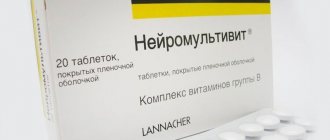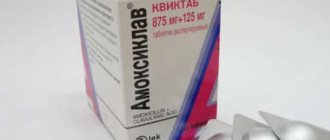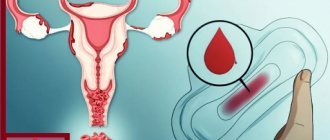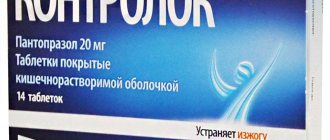Pharmacokinetics
Suction
After oral administration, it is absorbed from the distal small intestine.
Distribution
Accumulates in the liver, bones, skeletal muscle, kidneys, adrenal glands, myocardium, and adipose tissue. Cmax in tissues is reached after 4-5 hours.
Penetrates through the placental barrier. Excreted in breast milk.
Metabolism
Biotransforms in the liver and kidneys to active metabolites.
Removal
It is excreted mainly in feces, and in small amounts in urine.
pharmachologic effect
- The drug Vigantol is intended to regulate the metabolism of calcium and phosphorus-containing substances. The drug eliminates the lack of cholecalciferol in the body. The medication improves the absorption of calcium in the intestines and stomach, as well as the processing of phosphates in the kidneys. The drug enriches bone tissue with essential minerals and normalizes the functioning of the parathyroid glands.
The pharmaceutical product is well and quickly absorbed from the small intestine. The drug is distributed to internal organs and tissues through the bloodstream. The maximum concentration of the drug is reached in the body 4-5 hours after entering the body, and then gradually decreases. The components of the medication can pass into mother's milk and through the placenta, so the drug should not be taken by women during pregnancy and breastfeeding the baby naturally. Metabolism occurs through the liver and kidneys. The drug is excreted in urine or bile.
The action of Vigantol drops is aimed at the metabolic processes of calcium and phosphorus. Thanks to the use of the drug:
- Replenishes vitamin D3 deficiency;
- The absorption of calcium in the intestine and the reabsorption of phosphates in the kidneys are enhanced;
- Bone mineralization improves, which is a necessary condition for the normal functioning of the parathyroid glands.
The drug has a pharmacological effect regulating calcium-phosphorus metabolism.
VIGANTOL: DOSAGE
The drug is taken orally, the required amount of the drug solution is mixed with a spoonful of milk or other liquid.
To prevent rickets, full-term healthy children are prescribed Vigantol® 1 drop (about 500 IU) daily (take for 5 days, then a break of 2 days) starting from the 2nd month of life during the first and second year of life, excluding the summer months. Premature babies are prescribed 2 drops. For the treatment of rickets, 2-8 drops (about 1000-5000 IU)/day are prescribed from the 10th day during the first 2 months of life, as well as the 5th and 9th months of life; in the second year of life, 1 -2 courses during the winter-spring period.
To prevent the risk of diseases associated with vitamin D3 deficiency, prescribe 1-2 drops (about 500-1000 IU)/day (take for 5 days, then break for 2 days).
To prevent vitamin D3 deficiency in malabsorption syndrome, the drug is prescribed 4-8 drops (about 3000-5000 IU)/day.
For the treatment of osteomalacia caused by vitamin D3 deficiency, Vigantol® is prescribed in a dose of 2 to 8 drops (about 1000-5000 IU)/day. Treatment should be continued for 1 year.
As maintenance therapy for osteoporosis, 2-4 drops of Vigantol (about 1000-3000 IU)/day are prescribed.
In the treatment of hypoparathyroidism and pseudohypoparathyroidism, depending on the concentration of calcium in the plasma, 15-30 drops of Vigantol (about 10,000-20,000 IU)/day are prescribed. Calcium levels in the blood and urine should be monitored for 4-6 weeks, then every 3-6 months, and the dose adjusted according to normal blood calcium levels.
Vigantol instructions for use and analogues
Pathologies in the body sometimes appear due to insufficient vitamin D3 content. For prevention and often for the treatment of diseases that were caused by a lack of vitamin, a product called Vigantol is used. Instructions for use, as well as the properties and analogues of the drug will be discussed in this article.
Components and form of the medicine
The main and main active component of Vigantol is colecalciferol. One ml of the drug contains 0.5 mg of colecalciferol. Triglycerides are included as an auxiliary component.
The product is available in the form of glass ampoules equipped with a dropper, with a solution of 10 ml. The medicine has an oily, viscous appearance, with a yellowish tint. Drops are intended for oral administration. There is a form in the form of tablets.
The shelf life of the drug is 5 full years.
Properties of the drug
This medication is an antirachitic drug that compensates for the lack of vitamin D3, which is important for the absorption of calcium, and normalizes the phosphorus content in the body. Thanks to Vigantol, calcium is absorbed faster. There is an accelerated saturation of bone tissue with minerals. The substance allows you to regulate the functioning of the parathyroid glands.
Absorption occurs in the distal part of the small intestine. Distributed and accumulated in the adrenal glands, liver, bone structure, heart muscle, as well as in fatty tissues. After about five hours, the level of the drug reaches its maximum in the body, after which it declines. The excretion process occurs with the help of bile. The medication is also able to penetrate into milk, as well as penetrate the placenta.
Indications and contraindications for use
There are main indications for the use of the drug, for example:
- Softening of bone tissue;
- Rickets;
- The presence of frequent attacks of convulsions in the limbs.
Also, taking this drug is indicated for people suffering from pathological processes such as cirrhosis of the liver, resections in the large or small intestine. Drops are also prescribed as a preventive and medicinal product for insufficient vitamin D3 in the body. It is also recommended to take the drug for those who suffer from a lack of calcium or when it is poorly absorbed in the body. It is often prescribed in combination with other drugs to combat acne and for therapeutic purposes of psoriasis.
There are a number of recommendations for use during hypovitaminosis. The indication for taking the drug by people over 45 years of age is very important. At this age, calcium is more difficult to absorb, but its elimination occurs at an accelerated rate. In certain cases, you should take the drug when refusing calcium-containing products for certain reasons. In some people, necessary and healthy dairy products can cause allergies.
Contraindications to taking the solution are:
- Increased levels of calcium in the body;
- Individual intolerance to the main component of the drug;
- The period of bearing a child;
- For women during lactation;
- High percentage of calcium salts excreted in urine.
Before starting therapeutic measures, the doctor prescribes blood and urine tests to exclude the presence of factors prohibiting the use of the drug. It is not recommended to start taking it without consulting a specialist, as the condition caused by high calcium will worsen while taking the drug.
Not recommended, but in special cases it is allowed to take the drug in case of insufficient functioning of the liver, kidneys, damage to the heart muscle, diseases of the intestines and stomach, as well as in the presence of hypothyroidism.
Pregnancy and breastfeeding are not absolute prohibiting factors, since there is a risk of developing pathologies in the child, as well as possible negative consequences for the baby’s body when receiving the drug with milk. That is why, before you start taking it, you need to consult a doctor so that he can determine the need for it and also prescribe the permissible dose of the drug.
Method of administration and dosage of the drug
Drops should be diluted in a teaspoon or tablespoon of liquid and taken only in diluted form. Each case has its own dosage. For example, children without health problems should be given a drop of the drug for five days to prevent the development of rickets. The appointment is usually scheduled from the second month of life.
If the mother was unable to carry the baby to a safe time for birth, two drops should be given a week after birth. Just like in the first case, you need to take it for 5 days, after which you need a break for two days and again you need to take it for 5 days.
It is important to remember that in the summer, taking this remedy is not required, since the main source of the necessary vitamin is sunlight. –
If the child has been diagnosed with bone tissue pathology in the form of rickets, then taking the medicine is allowed from the 10th day after birth. In this case, the dosage ranges from a couple to eight drops. This course of therapy continues for the first two months of life, after which a break is taken and continues at 5 and 9 months of the baby’s life. The following times, take the medicine for preventive purposes to maintain vitamin levels in winter or spring.
Disease prevention means that adults only need to take the product for 5 days, one drop per day, after which a break is required for a couple of days.
Depending on the amount of the substance contained in a person’s plasma, if it is deficient, the doctor may prescribe taking the drug in an amount of 15 or 30. In this case, every 1.5 months, for the first time, you will have to monitor the calcium level, namely, take the necessary biochemistry tests. Later, monitoring can be done once every few months.
For osteoporosis, up to 4 per day are required. And in case of softening of bone tissue, which is caused by calcium deficiency, treatment must be followed for 12 months, taking up to 5 ml per day if necessary.
Side effects when taking the medicine
Despite its beneficial properties, in some cases, especially if taken incorrectly, side effects occur. Such side effects may not appear immediately and it will be quite difficult to identify them without testing. The main side effects when taking Vigantol are:
- Cardiopalmus;
- Attacks of nausea and vomiting;
- High levels of calcium in the body, as well as when excreted in the urine;
- Lack of appetite;
- Irritability and other nervous system disorders;
- Fast weight loss.
Side effects occur especially often if a person has a metabolic disorder.
Vigantol instructions for use, which are mandatory to study and follow, indicate that the medication should be taken taking into account the permitted dosage. Since in case of an overdose the following deviations from the condition occur:
- constipation or diarrhea;
- Thirst, feeling of dry mouth;
- Metallic taste in the mouth;
- Vomiting, nausea;
- Allergic reaction;
- Weakness, drowsiness;
- Development of pancreatitis, gastritis;
- Mental disorders;
- Less commonly, growth disturbance;
- Severe weight loss, possible development of anorexia;
- In a clinical study, the first time after dosing, an increased calcium content in the body will be detected.
In order to cure such a condition, it will take some time, stopping the medication, following a diet, drinking water and other liquids in increased quantities. In case of severe overdose, it will be necessary to rinse the body by administering specialized solutions intravenously, and also prescribe retinol, thiamine, ascorbic acid and other glucosteroids. No specific antidote for overdose has been identified.
How does it interact with other medications?
You should definitely learn about the interaction of Vigantol with other medications in order to avoid negative consequences and not reduce the effectiveness of therapy.
Antacids with particles of magnesium or aluminum are considered an unfavorable combination with Vigantol. First of all, this combination significantly increases the risk of possible intoxication.
When taking colesteramine or colestipol, an increase in dosage is required, since they are eliminated faster in combination with the drug.
Calcitonin and bisphosphonate can reduce the effect of taking Vigantol.
Glycosides that are used to treat heart diseases, as well as benzodiazepines, cause the development of hypercalcenmia. In this case, observation and study of the work of the heart muscle is required.
It is allowed to combine drugs similar to vitamin D3, but only if the patient strictly follows the doctor’s recommendations and remains under observation for some time. Your doctor will tell you how to take the medicine in combination with others.
Similar drugs
The most common analogue of the drug is Aquadetrim. Its main difference from Vigantol is the solution. Since Aquadetrim is characterized by an aqueous base of the drug, and the drops have an oily base. It is useless to discuss which of these drugs is better, since in some cases an aqueous solution will be more useful, and in another an oily base.
Other similar agents include: Videchol, vitamin D, Colecalciferol, Cholecalciferol. Alfaforcala, Videin.
If the doctor has prescribed any of the drugs, you should not decide on its replacement on your own. Since each remedy, despite similar indications and actions, has its own nuances of administration. There is a possibility that a person may become intoxicated or become allergic to the product.
Cost and supply of funds
This medicine requires a doctor's prescription. Cost variations in different pharmacies do not differ much from each other and range from 190 to 230 rubles, depending on the region in which the pharmacy is located.
Opinions about the drug
Reviews about Vigantol are varied, but mostly positive. Experts recommend it as a preventive measure and as an effective treatment even for the youngest patients. Proper use helps to avoid the development of serious pathologies or cure existing ones. But it should be remembered that, like any given remedy, it requires certain rules of administration.
Parents of children suffering from rickets noted noticeable improvements in their child’s health after a course of therapy. In rare cases, the effect was little noticeable or absent due to an incorrectly selected drug. Often, full recovery occurs only after a person has completed the entire course of therapy.
Most parents are satisfied with the results, even despite how many side effects are indicated in the instructions. They occur quite rarely. If a child feels unwell after taking the drug, you should inform your pediatrician.
An important factor that is described when compiling a review is the price of the medicine, which is not considered high for a product thanks to which the patient experiences positive dynamics in treatment.
To avoid the development of pathological processes, it is better to lead a healthy and active lifestyle. Proper balanced nutrition, moderate stress on the body and moderate exposure to fresh air will help get rid of many diseases and it is possible that you will not need to take any medications, but in certain cases medication will be prescribed to support the body.
How to forget about joint pain...
Joint pain limits your movements and full life...
- You are worried about discomfort, crunching and systematic pain...
- Perhaps you have tried a bunch of traditional methods and medicines, creams and ointments...
- But judging by the fact that you are reading these lines, they did not help you much...
Fortunately, there is an effective method for treating joints, which our readers have already successfully used! Read more …
travmaoff.ru
Overdose
Symptoms of hypervitaminosis D: early (due to hypercalcemia) - constipation or diarrhea, dry oral mucosa, headache, thirst, pollakiuria, nocturia, polyuria, anorexia, metallic taste in the mouth, nausea, vomiting, unusual fatigue, general weakness, hypercalcemia, hypercalciuria; late - bone pain, cloudiness of urine (appearance of hyaline casts in the urine, proteinuria, leukocyturia), increased blood pressure, skin itching, photosensitivity of the eyes, conjunctival hyperemia, arrhythmia, drowsiness, myalgia, nausea, vomiting, pancreatitis, gastralgia, weight loss; rarely - psychosis (changes in mentality and mood).
Symptoms of chronic overdose of vitamin D (when taken for several weeks or months for adults in doses of 20-60 thousand IU / day, for children - 2-4 thousand IU / day): calcification of soft tissues, kidneys, lungs, blood vessels , arterial hypertension, renal and chronic heart failure (these effects most often occur when hyperphosphatemia is added to hypercalcemia), growth impairment in children (long-term use at a dose of 1.8 IU/day).
Treatment: discontinuation of the drug, diet low in calcium, consumption of large amounts of fluid, administration of corticosteroids, α-tocopherol, ascorbic acid, retinol, thiamine, in severe cases - intravenous administration of 0.9% sodium chloride solution, furosemide, electrolytes, hemodialysis . There is no specific antidote. To avoid overdose, in some cases it is recommended to determine the concentration of calcium in the blood.
Vigantol: instructions for use
Vigantol solution for internal use is a vitamin preparation. It is used for the complex treatment and prevention of diseases accompanied by vitamin D deficiency, as it contains its active form, colecalciferol (vitamin D3) as an active ingredient.
Release form and composition
The drug Vigantol is an oil solution for internal use. 1 ml of solution contains the active substance colecalciferol (vitamin D3) in the amount of 20,000 IU (international units) or 0.5 mg. The cardboard package contains 1 glass bottle with 10 ml of solution and instructions for use of the drug.
pharmachologic effect
The active ingredient in Vigantol oral solution is colecalciferol (vitamin D3) - a fat-soluble vitamin that performs a number of biologically important functions in the human body:
- Increases the absorption of calcium ions and phosphoric acid salts from the intestinal lumen into the blood.
- Regulates the process of removing mineral salts from the body, primarily calcium and phosphates.
- Improves the mineralization of bone tissue, thereby increasing their strength.
- Takes part in the synthesis of ATP (adenosine triphosphoric acid) inside cells - this is the main compound that is an accumulator of intracellular energy released during the breakdown of organic substances.
Vitamin D3 is also necessary for the normal functioning of the parathyroid glands, the hormones of which are involved in regulating the level of calcium and phosphoric acid salts in the body.
After taking Vigantol oil solution orally, colecalciferol is quickly absorbed into the blood, where it reaches a therapeutic concentration within 20-30 minutes. Since vitamin D3
fat-soluble compound, its bioavailability and absorption are improved when the solution is taken together with food containing lipids. The active substance tends to accumulate in the body, in particular in adipose tissue and the liver, which must be taken into account when selecting the dosage and regimen of the drug.
Indications for use
The main indications for the use of Vigantol oil solution are conditions of the body accompanied by a lack of vitamin D in the body, a violation of the metabolism of calcium salts and phosphoric acid. These include:
- Rickets in children is a metabolic pathology associated with an insufficient amount of vitamin D3 in the child’s body and a decrease in the level of calcium in the blood, which leads to demineralization of bone tissue (decreased bone strength due to insufficient intake of calcium salts and phosphoric acid).
- Osteomalacia is a softening of bone tissue in children or adults due to impaired metabolism of mineral salts in the body.
- Osteoporosis in women during menopause is the leaching of calcium salts from bone tissue as a result of a decrease in the level of estrogen (female sex hormones).
- Spasmophilia is a predisposition to the development of seizures (happens more often in children) against the background of a decrease in the concentration of calcium ions in the body, necessary for the normal conduction of nerve impulses along the fibers.
- Hypoparathyroidism is insufficient functional activity of the parathyroid glands, accompanied by a decrease in the level of their hormones and calcium ions in the body.
- Complex therapy of acne (acne) and psoriasis (chronic degenerative-dystrophic skin pathology).
Vigantol oil solution for oral administration is also used for the prevention and treatment of hypovitaminosis (insufficient intake or synthesis of vitamin D) in the body.
Contraindications for use
The use of the drug is contraindicated in several pathological and physiological conditions of the body, which include:
- Individual intolerance or hypersensitivity to colicalciferol or auxiliary components of Vigantol oil solution.
- Hypercalcemia is a condition in which calcium levels in the body increase, and taking the drug only worsens this process.
- Hypercalciuria is increased excretion of calcium salts in the urine.
- Pregnancy at any stage and breastfeeding.
Determination of the possible presence of contraindications to the use of the drug is carried out even before the start of its use. To determine the presence of hypercalcemia or hypercalciuria, a biochemical laboratory test of blood and urine is performed.
Directions for use and doses
Vigantol oil solution is taken orally in drops that can be dissolved in a small amount of liquid. For better absorption of the drug from the intestines, it is recommended to take it after a meal containing animal or vegetable fats. The dosage is selected individually and depends on the age and purpose of treatment:
- To prevent the development of rickets in children aged 2 weeks (infants) - 1-2 drops of solution (about 500 IU) per day, sometimes for medical reasons or for premature children, the dose can be increased to 3-4 drops (about 1000 IU).
- For children aged 2 years, in winter, to prevent rickets, the drug is used in a dose of 3 drops 3 times a day.
- For the treatment of rickets in children over 2 years of age, Vigantol oil solution is taken 5 drops 3 times a day.
- For the treatment of spasmophilia, the drug is prescribed to infants in a dose of 10 drops 3 times a day.
- To prevent the process of osteomalacia in adults, the drug is prescribed in a dose of 1-2 drops per day, for treatment - 5 drops 3 times a day.
- During the treatment of hypoparathyroidism in adults, the drug is used in the amount of 15-20 drops per day (about 10,000 IU), with periodic monitoring of the level of calcium and phosphorus salts in the blood.
The duration of therapeutic or prophylactic use of the drug Vigantol is established on an individual basis, based on the normalization of the general condition of the child or adult, a decrease in the severity of clinical symptoms of the pathological process and the achievement of a stable normal level of calcium ions and phosphoric acid salts in the body.
Side effects
The main side effect of using Vigantol oil solution is the development of hypercalcemia or hypercalciuria, which is accompanied by the development of the following clinical symptoms:
- Acute disturbances in the rhythm and frequency of heart contractions (arrhythmia).
- Nausea, vomiting, unstable stool, abdominal pain, anorexia (lack of appetite), increased thirst.
- Impaired consciousness up to its complete absence, various mental disorders.
- Weight loss during long-term hypercalcemia.
- The development of urolithiasis caused by the deposition of calcium salts in the kidneys and urinary tract.
- Deposition of calcifications (insoluble calcium salts) in various organs and tissues with a corresponding disruption of their functional activity.
- In rare cases, polyuria may develop - an increase in the amount of urine produced and the number of urinations.
The development of side effects is more common in individuals with hypersensitivity to vitamin D3.
special instructions
Before you start taking Vigantol oil solution, you must carefully read the instructions for use of the drug. It is important to pay attention to a number of special instructions, which include:
- The drug is used with caution in case of concomitant sarcoidosis or the presence of calcium stones and calculi in the organs of the urinary system (kidneys, ureters, bladder).
- When using the drug in people with limited mobility (after applying plaster casts, having suffered a stroke), with a history of urolithiasis in the past, laboratory monitoring of the level of calcium salts and phosphoric acid in the blood and urine is periodically carried out.
- Use Vigantol oil solution with caution when taken simultaneously with thiazide diuretics (diuretics), as the risk of developing hypercalcemia increases.
- The drug does not affect the speed of psychomotor reactions and concentration.
Vigantol oil solution is available in pharmacies without a prescription. If you have any questions or doubts regarding its use, you should consult your doctor.
Overdose
When the recommended therapeutic dose of the drug is significantly exceeded, symptoms of hypercalcemia develop, which include the appearance of nausea, vomiting, disturbances in the rhythm and frequency of cardiac activity, changes in consciousness, up to its loss, hallucinations, anorexia (lack of appetite), and increased blood pressure. On the part of the kidneys, the development of polyuria is possible. To treat an overdose, gastric and intestinal lavage, laxatives and intestinal sorbents are used. To reduce the level of calcium in the blood, intravenous drip infusion of saline and the use of furosemide (a diuretic that promotes the excretion of calcium salts in the urine) are used.
Vigantol Analogues
Analogues of Vigantol oil solution in terms of active substance and therapeutic effect are Videin, Alfaforkala, Ideos.
Terms and conditions of storage
The shelf life of the drug from the date of manufacture is one year. The oil solution must be stored in a dark, dry place, out of reach of children, at an air temperature no higher than C.
Vigantol price
The average cost of Vigantol oil solution in Moscow pharmacies varies between 202-217 rubles.
bezboleznej.ru
Drug interactions
When taking Vigantol® simultaneously with thiazide diuretics, the risk of developing hypercalcemia increases.
When used simultaneously with phenytoin (increasing the rate of biotransformation), cholestyramine, corticosteroids, calcitonin, derivatives of etidronic and pamidronic acids, plicamycin, gallium nitrate, the effectiveness of the drug Vigantol® is reduced.
Retinol, when used simultaneously with Vigantol, reduces the toxicity of the latter.
Barbiturates, when used simultaneously with Vigantol, increase the rate of biotransformation of colecalciferol.
Vigantol®, when used simultaneously, increases the toxicity of cardiac glycosides.
Long-term therapy with Vigantol® against the background of simultaneous use of antacids containing aluminum and magnesium increases their concentration in the blood and the risk of intoxication (especially in the presence of chronic renal failure).
Cholestyramine, colestipol and mineral oils reduce the absorption of colecalciferol from the gastrointestinal tract, which requires increasing its dose when used simultaneously with the above drugs.
Colecalciferol increases the absorption of phosphorus-containing drugs and the risk of hyperphosphatemia.
When using Vigantol simultaneously with sodium fluoride, the interval between doses should be at least 2 hours, with oral forms of tetracyclines - at least 3 hours.
Concomitant use with other vitamin D3 analogues increases the risk of developing hypervitaminosis.
Release forms and composition
"Vigantol" - oil-based drops that contain 0.5 mg of colecalciferol per 1 ml of solution. This amount corresponds to 20,000 IU of vitamin D3. To fill the remaining volume, triglycerides are used, of which 30 drops are 939.5 mg. The drug is poured into glass vials with a drip nozzle with a volume of 10 ml each.
For protection from sunlight and ease of transportation, the bottle is packed in a pack of thin cardboard. It contains printed instructions, and the date of manufacture and expiration date are stamped on the outside. After its expiration, the drug loses its effectiveness; it is not recommended to use it after this.
Indications
- prevention and treatment of rickets;
- prevention of vitamin D deficiency in patients at high risk (malabsorption,
- chronic diseases of the small intestine,
- biliary cirrhosis of the liver,
- condition after resection of the stomach and/or small intestine);
- hypocalcemia;
- hypocalcemic tetany;
- osteoporosis (of various origins);
- osteomalacia (against the background of mineral metabolism disorders in patients over 45 years of age,
- prolonged immobilization in case of injury,
- following a diet that excludes milk and dairy products);
- treatment of hypoparathyroidism and pseudohypoparathyroidism.
Reviews
As a prevention of vitamin D deficiency, the child was prescribed Aquadetrim. But after taking it, an allergic reaction began. I think it was caused by an overdose of vitamin D. And then the question arose: what to give the baby? After reading a lot of good reviews, I settled on Vigantol. Analogues were not suitable in our case.
After the first use, no adverse reactions occurred. She gave 1 drop per day, along with a spoonful of milk. I liked that the kit included a pipette, it’s convenient to measure the required number of drops.
In my opinion, Vigantol is preferable to Aquadetrim; there are fewer adverse reactions in children.
Vigantol is the best source of vitamin D other than the sun. The drug is produced in Germany, which indicates its high quality. It has no taste or smell, can easily be added to milk, and the baby will not even notice that he took Vigantol. An overdose of the drug is unlikely if you first consult a doctor.
The medicine is sold in a glass bottle, the upper part is closed with a dispenser stopper. In summer, the child receives enough vitamin D from the sun and milk. In winter, it is enough to take 1 drop per day.
My son was born in the fall, and at this time of year we have quite a bit of sun. And during one of the doctor’s examinations, we were prescribed vitamin D to prevent rickets. We started drinking it until spring. All signs of rickets completely disappeared. But the doctor said that I need to take vitamins again until the age of 3, except in the summer. I am completely satisfied with Vigantol, we have not experienced any side effects.
| Buy Vigantol (Germany) | |
| [contact-form-7 > | |
Contraindications
- hypercalcemia;
- hypercalciuria;
- sarcoidosis;
- calcium nephrourolithiasis;
- thyrotoxicosis (possibility of hypersensitivity);
- renal osteodystrophy with hyperphosphatemia;
- hypervitaminosis D;
- hypersensitivity to vitamin D3.
The drug should be prescribed with caution for atherosclerosis, heart failure, renal failure, pulmonary tuberculosis (active form), hyperphosphatemia, phosphate nephrolithiasis, organic heart damage, acute and chronic liver and kidney diseases, gastrointestinal diseases (including gastric ulcer and duodenum), during pregnancy and lactation, and with hypothyroidism.
Analogs
If Vigantol is not available in pharmacies, it can be replaced with analogues.
The main substance in the drops is cholecalciferol (vitamin D3). The drug is available in a 10 ml glass bottle.
Indications for use:
- Osteomalacia.
- Hypocalcemic tetany.
- Rickets.
- Insufficient amount of vitamin D.
- Metabolic osteopathies.
- Hypercalciuria.
- Hypervitaminosis.
- Hypercalcemia.
- Sarcoidosis.
- Urolithiasis disease.
- Kidney failure.
The dosage is determined depending on the vitamin D content in the diet and medications taken.
Price - 200 rubles.
Videohall
The composition of the drops is similar to Vigantol. The drug regulates the exchange of calcium and phosphorus in the body. Used for the treatment and prevention of rickets and osteoporosis. The dosage is prescribed depending on the disease.
- Hypersensitivity to any of the components of the drug.
- Tuberculosis.
- Peptic ulcer disease.
- Chronic kidney and liver diseases.
Price - 190 rubles.
Alfaforcal
The medicine is available in capsules that contain alfacalcidol. The drug increases the absorption of phosphorus and calcium by the intestines. When completing the full course of treatment, muscle and bone pain decreases. The maximum concentration of the drug in the blood occurs 8 hours after administration, which is similar to Vigantol.
Indications for use:
- Osteoporosis (main forms).
- Hypoparathyroidism.
- Rickets.
- Psoriasis.
- Fanconi syndrome.
- Hyperparathyroidism.
- Hypersensitivity to one of the components of the drug.
- Liver diseases.
- Lactation and pregnancy period.
- Hypermagnesemia and hypercalcemia.
- Peptic ulcer disease.
- Headache.
- Nausea.
- Dry mouth.
- Itching.
- Tachycardia.
The duration of the course and dosage are determined by the doctor after examination.
Price - from 190 rubles.
Vigantol is an effective medicine for the treatment and prevention of rickets in children. It can be prescribed to newborns, which is a big advantage. The drug has no taste, which makes it easier to use. Before using Vigantol, you must read the instructions.
During pregnancy and lactation
The active substance of the drug, colecalciferol, can penetrate the placental barrier, so its use during pregnancy is not recommended. This can cause premature ossification in the fetus, which will negatively affect the course of labor. In case of acute deficiency of vitamin D3 in a woman, taking Vigantol may be allowed under the supervision of a specialist.
Vitamin D3 metabolites pass into mother's breast milk. This can provoke overgrowth of fontanelles in infants if the dosage is exceeded. The decision to take the drug by the mother is made by the pediatrician based on the child’s condition and the child’s use of “Vigantol” orally in the form of drops.










